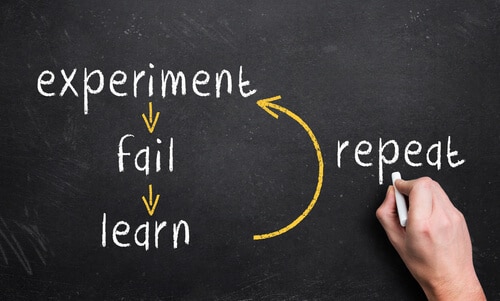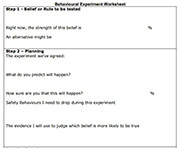
Either during your sessions or between your sessions, you can use behavioural experiments to test the beliefs you hold and to help you to develop more useful beliefs. Behavioural experiments are often used alongside thought records, which are about helping you to learn to think about things in a different way. Behavioural experiments complement thought records by helping you to test the beliefs that cause problems (for example, such as the belief that you are naturally cowardly) and by testing new, more useful beliefs. In the process, you can actually learn to feel and experience the new beliefs and to assimilate them on an emotional as well as an intellectual level.
You will be given a form to fill in with a number of categories and asked to fill in the belief to be tested. For example, the belief could be, “I am a naturally cowardly person and whenever I am asked to do anything demanding everyone can see that I am scared.” You also assign a percentage of certainty. For instance, you might assert that you believe in the above statement with an 80% degree of certainty.
Then, with your therapist’s help, you will be asked to provide an alternative view of what is going on with you and to note this on the form. For example, you might construct an alternative belief that states: “I worry that I am cowardly but actually I am just a bit nervous, as anyone might be, and I am still able to conduct myself appropriately.” Again, you assign a percentage of certainty. You might say that you believe in this statement with a 30% degree of certainty. Of course, this also means that you need to adjust downwards the percentage you assigned to the earlier, more negative, point of view.
In order to ascertain which belief is true, you will be asked to do a behavioural experiment. In this case, you might be asked to request that your friends or colleagues provide an honest response to questions about how you are seen to conduct yourself when you are called to do something challenging or demanding, with points given out of ten. Before obtaining the results, you provide an estimate of what they are likely to reveal. You might have a very negative view of how others perceive you when you are doing something you find challenging, and find that others’ impressions of you are more positive than you imagined. In consequence, the original belief is challenged, and your percentage of certainty has to be revised.
In order for this approach to work well, you and your therapist need to work together to understand which beliefs are causing a problem and to devise an effective, intelligent way of testing them. It is important for the approach to synchronise in a natural fashion with your typical social and work environments and not to become a new source of stress!
With this approach, over time your negative beliefs about yourself are challenged more and more, and you should become more confident in response to the more useful beliefs that you develop. When this approach is carefully tailored to your belief system and needs, it can be a very powerful tool on your path to recovery.
WHO CAN I SPEAK TO FURTHER ABOUT THE ISSUES IN THIS ARTICLE?
For help with the issues discussed in this article speak to one of our therapists here at Private Therapy Clinic for a free initial chat or to make an appointment.
















